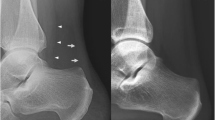Abstract
Objective
To assess the sensitivity of ultrasound in detecting soleus muscle lesions diagnosed on magnetic resonance imaging (MRI) and to characterize their location, ultrasound pattern, and evolution.
Materials and methods
Ultrasound and MRI studies were performed between May 2009 and February 2013 on all patients who presented to the Medical Services Clinic of the Catalan Sport Council with the initial onset of sharp pain in the calf compatible with injury of the soleus muscle. An inter-observer ultrasound reliability study was also performed.
Results
A total of 55 cases of soleus injury were studied prospectively (22 with right leg involvement, 33 left) by ultrasound and MRI, which was utilized as the “gold standard.” In MRI studies, 24 cases (43.7 %) had myofascial injuries that were localized in the posterior aponeurosis (PMF) in 15 cases (27.3 %) and in the anterior aponeurosis (AMF) in 9 (16.4 %). Thirty-one cases (56.3 %) were musculotendinous injuries, with 9 cases (16.4 %) in the medial aponeurosis (MMT), 11 cases (20 %) in the lateral aponeurosis (LMT), and 11 cases (20 %) in the central tendon (CMT). In comparison to MRI, ultrasound was able to detect injury to the soleus in 27.2 % of cases. No injuries were detected by ultrasound alone. Posterior myofascial injuries were more likely to be detected by ultrasound than anterior myofascial injuries or all types of musculotendinous injuries. Ultrasound patterns for each type of injury were described.
Conclusion
Ultrasound is not a sensitive technique for detecting and assessing soleus traumatic tears compared with MRI, although the sensitivity is enhanced by a thorough anatomically based ultrasound examination. Timing of the ultrasound examination may be of importance. Each type of soleus injury appears to have a characteristic ultrasound pattern based on a defect of connective expansions, the existence of small myofascial filiform collections, and the rarefaction of the fibrillar area.







Similar content being viewed by others
References
Gilbert Jr TJ, Bullis BR, Griffiths HJ. Tennis calf or tennis leg. Orthopedics. 1996;19(2):179–84.
Elias JJ, Faust AF, Chu YH, Chao EY, Cosgarea AJ. The soleus muscle acts as an agonist for the anterior cruciate ligament. An in vitro experimental study. Am J Sports Med. 2003;31(2):241–6.
Soukupa T, Zachařováa G, Smerdub V. Fibre type composition of soleus and extensor digitorum longus muscles in normal female inbred Lewis rats. Acta Histochem. 2002;104(4):399–405.
Balius R, Alomar X, Rodas G, Miguel-Pérez M, Pedret C, Dobado MC, et al. The soleus muscle: MRI, anatomic and histologic findings in cadavers with clinical correlation of strain injury distribution. Skeletal Radiol. 2013;42:521–30.
Courthaliac C, Weilbacher H. Imaginerie du mollet douloureux chez le sportif. J Radiol. 2007;88:200–8.
Testut L, Latarget A. Anatomía Humana. 9th ed. Barcelona: Salvat Editores; 1979. p. 1149–98
Smigielski R. Management of partial tears of the gastro-soleus complex. Clin Sports Med. 2008;27:219–29.
Hodgson J, Finni T, Lai A, et al. Influence of structure on the tissue dynamics of the human soleus muscle observed in MRI studies during isometric contractions. J Morphol. 2006;267:584–601.
Joshi SS, Joshi SD, Kishve PS. Feathered fibres of human soleus. Int J Morphol. 2010;28:239–42.
Chow RS, Medri MK, Martin DC, Leekam RN, Agur AM, McKee NH. Sonographic studies of human soleus and gastrocnemius muscle architecture: gender variability. Eur J Appl Physiol. 2000;82:236–44.
Garrett Jr WE. Muscle strain injuries. Am J Sports Med. 1996;24:S2–8.
Dixon JB. Gastrocnemius vs. soleus strain: how to differentiate and deal with calf muscle injuries. Curr Rev Musculoskelet Med. 2009;2:74–7.
Koulouris G, Ting AYI, Jhamb A, Connell D, Kavanagh EC. Magnetic resonance imaging findings of injuries to the calf muscle complex. Skeletal Radiol. 2007;36:921–7.
Noya J, Sillero M. Incidencia lesional en el fútbol profesional español a lo largo de una temporada: días de baja por lesión. Apunts Med Esport. 2012;47(176):115–23.
Delgado GJ, Chung CB, Lektrakul N, et al. Tennis leg: clinical US study of 141 patients and anatomic investigation of four cadavers with MR imaging and US. Radiology. 2002;224(1):112–9.
Cavalier R, Gabos PG, Bowen JR. Isolated rupture of the soleus muscle: a case report. Am J Orthop. 1998;27(11):755–7.
Kane D, Balint PV, Gibney R, Bresnihan B, Sturrock RD. Differential diagnosis of calf pain with musculoskeletal ultrasound imaging. Ann Rheum Dis. 2004;63:11–4.
Nazarian LN. The top 10 reasons musculoskeletal sonography is an important complementary or alternative technique to MRI. AJR Am J Roentgenol. 2008;190:1621–6.
Bianchi S, Martinoli C, Abdelwahab IF, Derchi LE, Damiani S. Sonographic evaluation of tears of the gastrocnemius medial head (“tennis leg”). J Ultrasound Med. 1998;17:157–62.
Conflict of interest
None.
Ethics approval
Ethics approval was obtained from the Consell Català de l’Esport.
Author information
Authors and Affiliations
Corresponding author
Rights and permissions
About this article
Cite this article
Balius, R., Rodas, G., Pedret, C. et al. Soleus muscle injury: sensitivity of ultrasound patterns. Skeletal Radiol 43, 805–812 (2014). https://doi.org/10.1007/s00256-014-1856-z
Received:
Revised:
Accepted:
Published:
Issue Date:
DOI: https://doi.org/10.1007/s00256-014-1856-z




